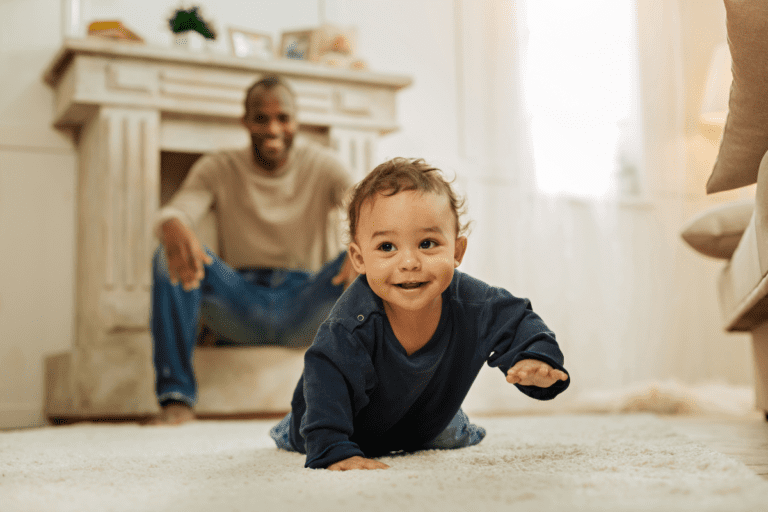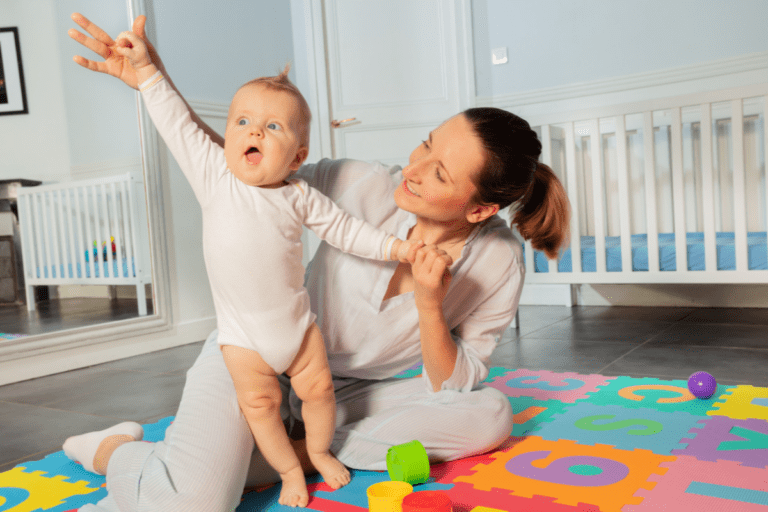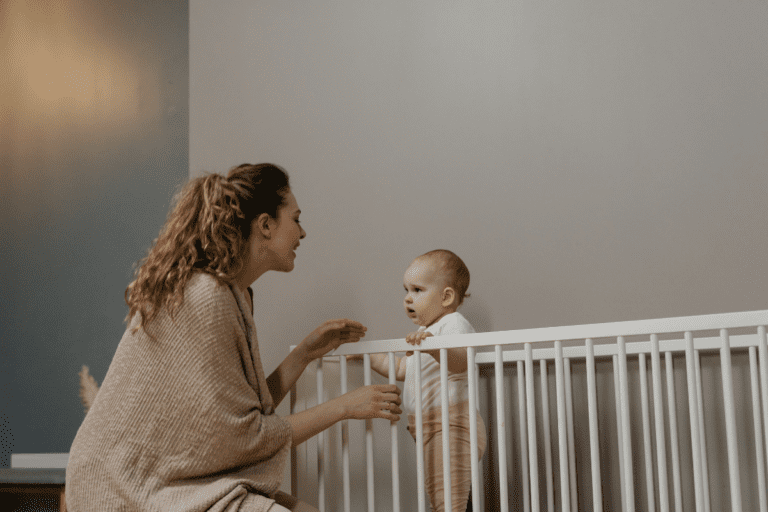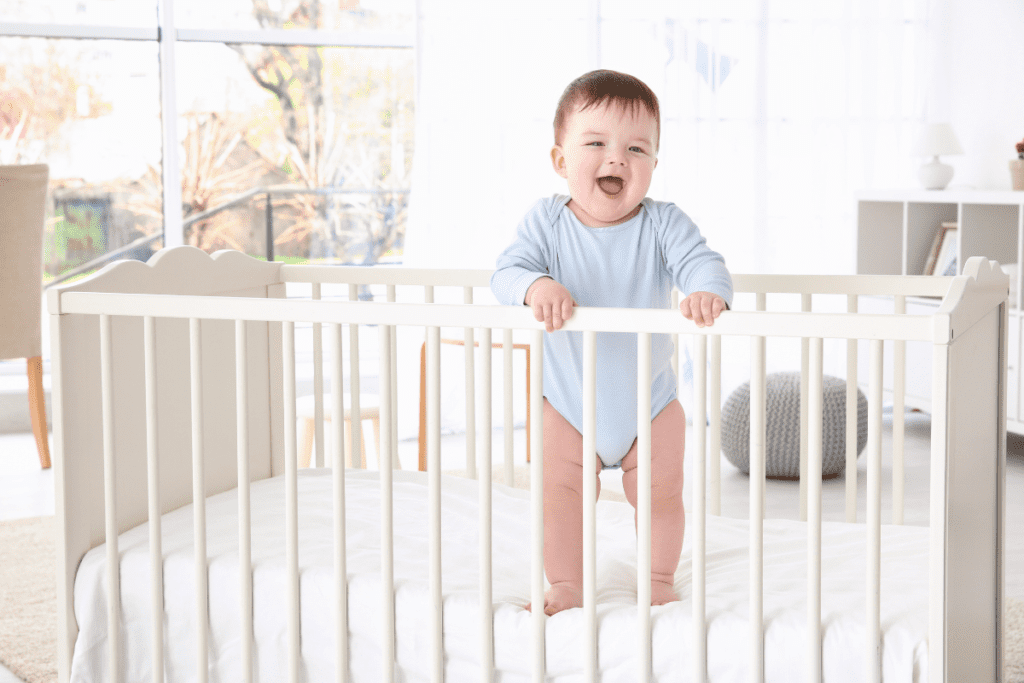Baby Won't Lay Down To Sleep
Milestones are such an exciting time in our baby’s lives. When baby rolls over for the first time or when you first hear them giggle, we’re overjoyed. Baby giggles are the best. Then they start getting more mobile, crawling, sitting up, couch surfing and eventually pulling to stand and walking! As parents we’re so eager to see our baby achieve these milestones. But often it opens up a whole new world that we’re not prepared for quite yet!
Your baby can now get to places and reach items that you may not want them to! We’re in full on baby proofing mode (lower that crib mattress). We’re extra cautious about what our baby is doing at all times. In addition to all of this, new milestones can often wreak havoc on our baby’s sleep, especially when your baby won’t lay down to sleep.

Learning New Skills
Even the best sleepers can take longer to fall asleep or have middle of the night wakings once they’ve learned a new skill. Why? Once our baby learns something new, they want to practice it all of the time. Yes even in the middle of the night. How convenient for us.
Some babies can get back to sleep without parent intervention. Eventually once they’ve mastered this skill these sleep disruptions stop altogether (until a new one comes along). Other babies really start struggling with sleep once they can sit up or stand. It seems they have it down better during the day when you’re right there. But when in their crib alone they’re unable to lay down and fall asleep.
Most parents I work with whose babies are over 6 months are worried that they’ve waited too long to work on sleep. They feel that it will be much more challenging to change their baby’s sleep habits. However, this is not really the case. I’m a firm believer in the saying, “it’s never too late to make a change”.
The problem becomes when your baby has learned this new skill (like standing) and now we’re trying to teach them another new skill, like self-soothing and falling asleep independently. Your baby is not going to like this change at first so most likely they are going to be standing in their crib protesting and crying and sometimes even falling asleep this way.
I always make sure to talk about this at length with my clients when we discuss bedtime because every baby is different, and we don’t truly know how they are going to respond to the sleep plan. I want parents prepared for all possibilities.
So, if you’re reading this you’re most likely dialed in because your little one is falling asleep standing up or having a hard time laying down for sleep. You don’t want to just leave your child standing up asleep, as they could fall and get hurt. But on the other hand we don’t want to be running in and out laying them down over and over again.

Practice During the Day
The best approach is to work on this proactively during the day while you’re right next to them versus trying to master this at bedtime. Help them develop the standing to sitting skill by modeling this with them. It also helps to have a favorite toy nearby that you can put near them while they’re standing up. Encourage them to sit down and grab their toy. This will help them master the skill faster, but nighttime may still be challenging.
How Does Your Child Fall Asleep?
If your child is not an independent sleeper, meaning they don’t fall asleep on their own, you may be running into this issue in the middle of the night. They’re laid down asleep but when they wake up needing some help. They don’t realize they have to lay down for sleep to come or they really need your help getting back to sleep. This is where hiring a sleep consultant to help guide you through these challenges is beneficial.
Your child may be able to fall asleep independently, but now with this new skill, they’re having trouble laying down from a standing position. Again, this is new to them so they may not realize they need to lay down for sleep to come.

How to Assist Them at Bedtime
Either way, you can choose to stay in the room or do check ins to help assist your little one with this whole standing and laying down conundrum. I advise only laying them down once or twice and if they pop right back up, don’t continue to lie them down. Your baby will calm down much faster if she decides to lie down on her own. Instead, pat the mattress and tell her to lie down or say “lay down, it’s sleepy time”.
If you’re in the room with her take pauses in between attempts and use your voice and touch to calm her. Sometimes a parent’s presence can upset baby more. If you are doing check ins attempt to lay your baby down or pat the mattress when first entering the room. Stay for less than a minute, waiting in between check ins (I recommend 10 minutes between).
If your baby starts to doze off in a standing position, gently lay your baby down. Your baby may wake and start crying all over again, but it is better than your baby falling over and getting hurt.
This often happens because your baby is having a mini nap standing, so she may have relieved enough sleep pressure to not be as tired when you go in to lay her down. Also, your baby is still tired and wants to sleep but is struggling to do so, because she’s frustrated. This will improve as your baby learns to put herself to sleep at bedtime. After a few days this should resolve and your child should be able to lay down on their own.
If you find yourself struggling with a new milestone or you baby’s sleep overall, consider a customized sleep package. All of my one-on-one clients receive a customized sleep plan and follow up support so you’re going to see success quickly. Book your free sleep solution call with me today.

